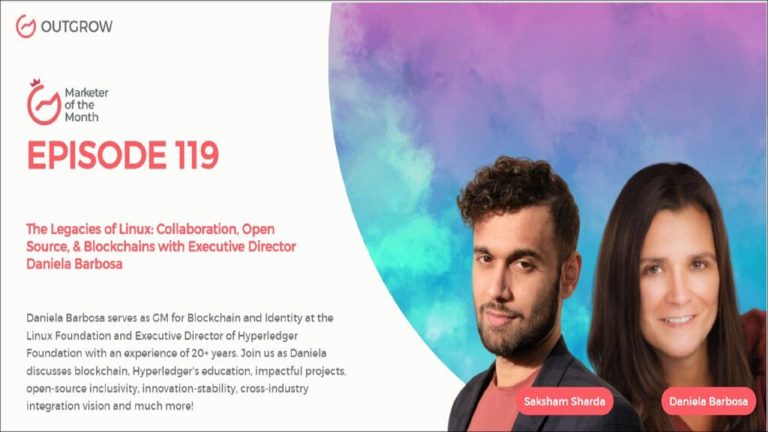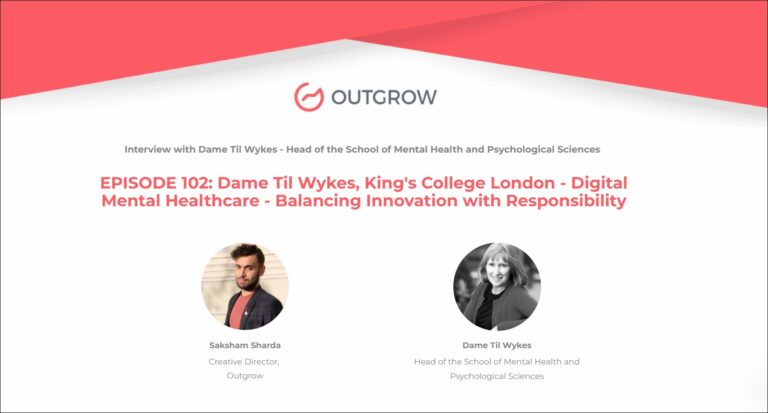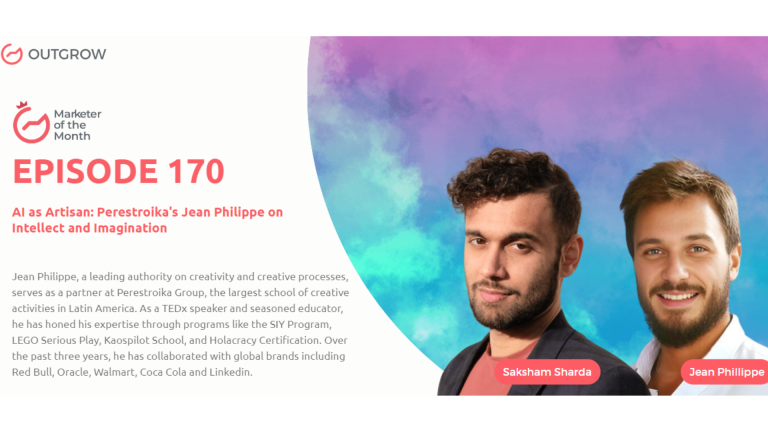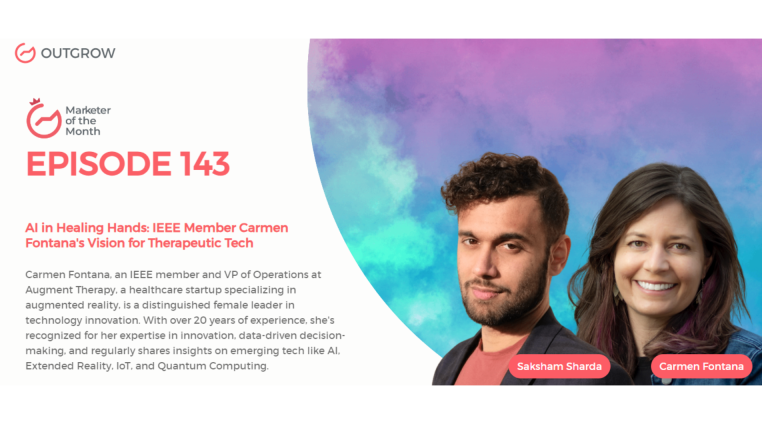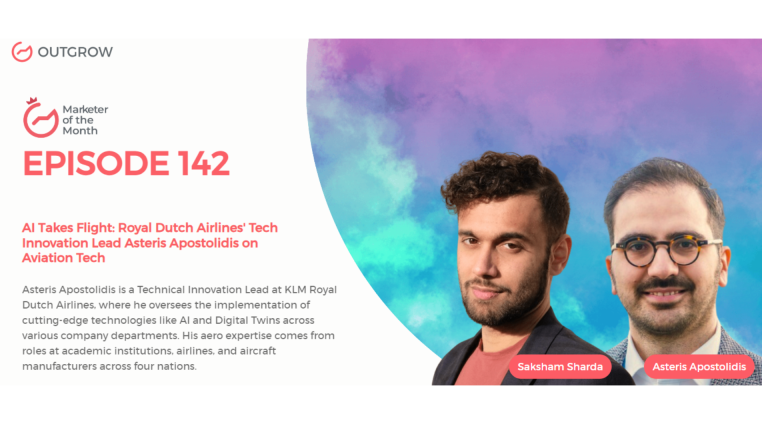Hey there! Welcome to the Marketer Of The Month blog!
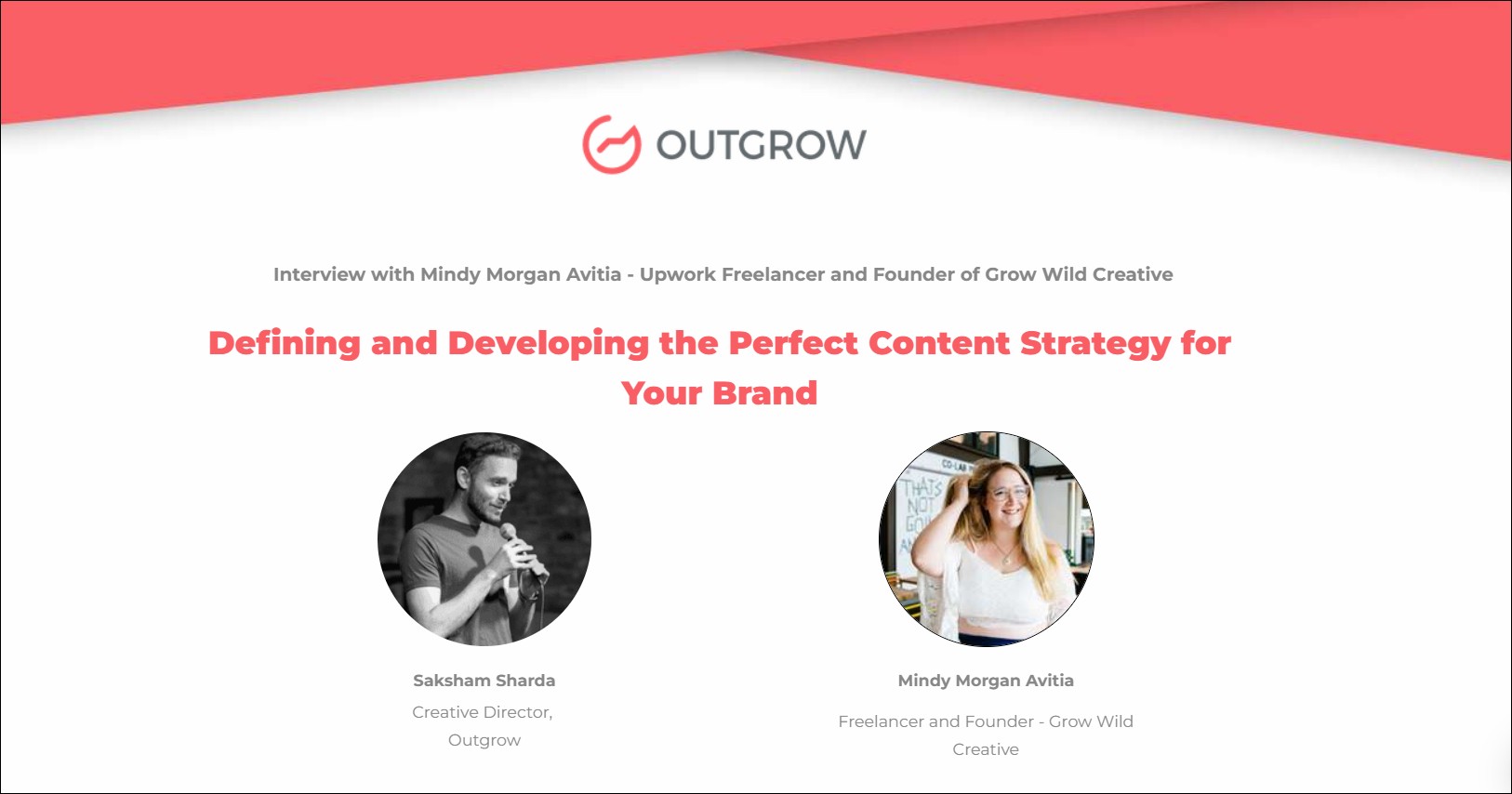
We recently interviewed Freelancer of the Month ‘Mindy Morgan Avitia‘ for our monthly podcast – ‘Marketer of the Month’! We had some amazing insightful conversations with Mindy and here’s what we discussed about –
1. Why robust marketing is incomplete without honing your writing and focusing on content
2. Tips for writers to create non-branded, searchable content to attract unfamiliar readers
3. Measurable goals to realize a fruitful marketing strategy
4. How Mindy assisted an impact-driven eCommerce site become thought leaders in their industry
5. Competitor analysis in the content industry
6. Tips for writing high-quality long-form content
About our host:
Dr. Saksham Sharda is the Chief Information Officer at Outgrow.co He specializes in data collection, analysis, filtering, and transfer by the means of widgets and applets. Interactive, cultural, and trending widgets designed by him have been featured on TrendHunter, Alibaba, ProductHunt, New York Marketing Association, FactoryBerlin, Digimarcon Silicon Valley, and at The European Affiliate Summit.
About our guest:
Mindy is a content strategist and writer who specializes in complex, social impact B2B companies. She collaborates with individuals and businesses to create content strategies that increase revenue, strengthen brand positioning, and foster long-term relationships.
Defining and Developing the Perfect Content Strategy for Your Brand
Table of Contents
The Intro!
Saksham Sharda: Hi, everyone. Welcome to another episode of Outgrow’s Marketer of the Month. I’m your host, Dr. Saksham Sharda. I’m the Creative Director at Outgrow.co And for this month, we have a special series of freelancers of the month for which we are going to interview Mindy Morgan Avitia. Thanks for joining us, Mindy.
Mindy Morgan Avitia: Yeah, thanks for having me.
Don’t have time to read? No problem, just listen to it on Spotify!
The Rapid Fire Round!

Saksham Sharda: So Mindy, we’re going to start the rapid-fire round just to break the ice, you get three passes. In case you don’t want to answer the question. You can just say pass, but try to keep your answers to one word or one sentence only. Okay?
Mindy Morgan Avitia: Okay.
Saksham Sharda: So the first one, at what age do you want to retire?
Mindy Morgan Avitia: 50
Saksham Sharda: How long does it take you to get ready in the mornings?
Mindy Morgan Avitia: Between 15 minutes and an hour.
Saksham Sharda: The most embarrassing moment of your life?
Mindy Morgan Avitia: Pass.
Saksham Sharda: Your favorite color?
Mindy Morgan Avitia: Green.
Saksham Sharda: What time of the day are you most productive?
Mindy Morgan Avitia: Mid-morning
Saksham Sharda: Fill in the blank and the upcoming marketing trend is __________.
Mindy Morgan Avitia: AI copywriting
Saksham Sharda: The city in which the Best Kiss of your life happened?
Mindy Morgan Avitia: Austin, Texas.
Saksham Sharda: Pick one Mark Zuckerberg or Jack Dorsey?
Mindy Morgan Avitia: Neither.
Saksham Sharda: So that’s the pass then. The first movie that comes to your mind when I say the word ambition is?
Mindy Morgan Avitia: Forrest Gump
Saksham Sharda: How do you relax?
Mindy Morgan Avitia: I read.
Saksham Sharda: How many cups of coffee do you drink per day?
Mindy Morgan Avitia: Between two and three.
Saksham Sharda: A habit of yours that you hate?
Mindy Morgan Avitia: I am hypochondriac
Saksham Sharda: The most valuable skill you’ve learned in life?
Mindy Morgan Avitia: To pause before I want to react.
Saksham Sharda: And the last question is your favorite Netflix show?
Mindy Morgan Avitia: “Stranger Things”, I guess that’s what’s on top of my mind.
Saksham Sharda: Okay, so you had two passes, so you score like 8/10. That was great.
The Big Questions!

Saksham Sharda: Now we’re gonna go onto the bigger questions. The first one is, that you’ve told us that you helped one international NGO define its voice and earn more revenue from email content. Could you tell us how you achieve that?
Mindy Morgan Avitia: Yeah, so they are a rather big international NGO. And they have a pretty robust marketing department for a nonprofit. And they had all of the right pieces to have great content, especially with their email strategy, with the audiences that they already had. And so they had, buyer journeys, donor journeys, they had a great brand strategy, they had a content strategy. So they had the tone and voice but their content wasn’t quite matching up to all of the planning and preparation that they did. And it was a very traditional nonprofit, donate, hear the sad song of all of the things that are wrong in the world. And what I did was study all of the preparation that they had done before developing a voice around, and connecting with other humans. At the end of the day, that’s what marketing is, that’s what communication is, really connecting with other humans. And once you have an email list, those are humans who have opted in to hear about you. So it’s even more important to hone in on a specific tone and voice. So I did that in terms of writing, I refined their writing. And then we got more practical around our tests and our hypotheses. And so now we’re learning as we go, and we’re refining, so what helps click-through rate because you have the benchmarks, and you have what other nonprofits are doing and the practical application of what works for them is different and so that’s what we’re doing. And we’re refining and slowly, but surely we’re growing revenue, campaign over campaign, month over month, and we’re seeing great success.
Saksham Sharda: And how did the nonprofit find you in the first place?
Mindy Morgan Avitia: They found me through an agency partner. So I work with an agency, as a contractor with them, and they found me through that agency partner.
Saksham Sharda: And how was the experience for you personally working with them?
Mindy Morgan Avitia: I love it! I mean my focus and my niche are impact-driven brands. That’s not just nonprofits, it’s anything but around values-based companies. And so, international NGOs are a great example of like the heart and soul of their communications and their marketing. And it’s a unique challenge because they don’t always have a product to sell. And so it’s rooted in storytelling. So that’s who I am at my core. I have a great time with them.
Saksham Sharda: And so what pointers do you have for writers looking to produce non-branded searchable content, to draw in readers who aren’t familiar with your brand but are looking for more details on a relevant subject?
Mindy Morgan Avitia: Yeah, that’s a great question. Because I think a lot of internal marketing departments, especially with the brands that I work with, who tend to be more medium-sized businesses, have robust resources of their case studies and their customers and what their customers like and what they don’t like. And I think, when you’re writing non-brought, non-branded content, it’s important to think externally and do the research with that in mind, around external audiences. So if you’re doing topic research, what are people searching for? And what are those high impressions? What are the high search volumes? And not only that, because if you’re starting from the ground up with SEO, specifically, just targeting high search volume or high impressions, it’s probably not going to render great results, because we have to also have some more possible easy keyword difficulty. So that’s my sweet spot with telling people to find that topic research that has a decent amount of volume, and low competition in the space to start building up that non-branded content and focusing on the intention of what you’re writing versus just these keywords that might not make sense. I think Google and Google bots have gotten a lot smarter over the years. And they don’t like keyword stuffing. And so just focusing on true value, I think one tactical thing that brands tend to do is if they’re writing a listicle or something, they’ll always plug in their brand, somewhere in that listicle. And sometimes it may be relevant, but often it’s not, I think there are other options for retargeting, or some call to action at the end if people want to continue. But I think people can sniff out pretty quickly this bait and pitch idea around an intriguing headline that’s going to answer their question, and then they’re just getting sold to and in the second answer of the listicle, or something like that. So that’s a best practice to avoid I would say, and one the consumers are a lot smarter than we give them credit for sometimes.
Saksham Sharda: And so could you give us an example of a small or medium business with whom you’ve worked and try to implement some of these strategies?
Mindy Morgan Avitia: Yeah, so I’m working with an e-commerce brand right now. They are focused on young girls’ empowerment through arts and esteem education, specifically around activity books, and things like that. And they were successful, their revenue was successful. Their sales were just growing month over month, year over year, and what the founder wanted was to be a resource for caregivers and for parents of the girls who are using their products. And so what I did was come in, do the topic research, do the competitor analysis, and do the overall research around what people who are buying your products want outside of just the sale. Do they just want the sale or do they want more engaging content that’s going to help their girls? Because if you’re buying a coloring book that’s meant to empower your young elementary school-aged girl, likely, you’re also going to find articles around cyberbullying, and all of these things that are impacting girls helpful. So what I did was find, and do the topic research around brand alignment and mission & vision alignment. So we can hone in on the topics. There was a great resource of ideas that just came from the marketing department. We think this is a great thing to write about, we think this is a timely topic. And then I came in with the research to say, “Hey, this is probably the biggest area of opportunity for us to grow because again there’s that high search volume, low difficulty.” And so now we’re building up our positions and our rankings. And the non-branded content is growing rapidly. Whereas before they were only ranking for their brand names. And now we’re ranking for much more along the lines of their new mission and the new direction of content they want to take. So it’s great. And it’s super fun. It’s again aligned with the impact of the brands that I love to work with.
Saksham Sharda: What kinds of attainable, measurable goals would you suggest establishing to realize a fruitful marketing strategy?
Mindy Morgan Avitia: Yeah, that’s like a huge question. I think one incredibly important thing is just the consistency of the reporting. I think smaller marketing departments tend to have great ideas, and then little resources to follow through. And so instead of having huge lofty goals, just being consistent with a few short goals that are impactful, like if you want to increase your brand awareness, what is the average session time people are reading your pages? And are they engaging? And what are they moving down the funnel? Are they eventually buying your products or signing up for your email list? All of these things are important goals. But I think to back up, the biggest question is, I always compare it to how people say, “I want to lose weight”, where losing weight is not necessarily the goal. The goal is to wake up every morning and eat breakfast, or to wake up every morning and exercise or whatever. That’s the goal. And so if you just say I want to earn more revenue, I want more donations, I want more traffic, there’s a lot of different roads to get there, just like losing weight. So really focusing on a couple of avenues to get there and then measuring that over time and refining. I mean monthly meetings around metrics go so far because even though tools like Google Analytics are catching, and capturing everything in real time, having the report and the dashboard all come together and discuss and then analyze and move forward with, is huge, because you can refine, you can throw away things that aren’t working. And yeah, I don’t know if that answered the question.
Saksham Sharda: It was a very huge question. Well, so what do you think about traffic then? Traffic is one of the hardest components to crack when it comes to succeeding online. And some say it’s even the holy grail of marketing. So do you agree with that statement?
Mindy Morgan Avitia: I think it depends on your brand, your product, what you’re trying to sell, and who you’re trying to talk to. I think some people are super successful, and they don’t even have a website. You know, they’re just on Instagram, they’re just on Tik Tok, they’re influencers. I’m thinking of a really good friend who has a service around helping moms with home management, she doesn’t have a website, she just has an Instagram and is wildly successful with it. So traffic doesn’t matter, to her website. And so she’s not thinking of searching and rankings and position tracking and all of that stuff. So yeah, it just really depends on your brand and what makes sense for you. And if it does make sense for you, then traffic matters a lot.
Saksham Sharda: So could you talk a little bit more about the impact of an E-commerce site that you’ve worked with?
Mindy Morgan Avitia: Yeah, so that’s what I was talking about a little bit before, around the girls’ empowerment products. And like I said, we did very extensive topic research around what people were searching within the niches, and from there to create a content strategy, we drill down on both what the content and the brand strategy was of the organization and what people were searching for. And so marrying those two things was my role in the company so I could help really both keep the mission and the human-centered values aligned with the content. So it wasn’t just all very heavy SEO written content form. A third-party agency that is getting great rankings, but it’s not converting to move people down the funnel or whatever. And so we dove into competitor analysis, how other people were talking about and what they were writing about, and what those gaps were that we could target specifically. And it’s been successful. As I said, we’ve seen substantial, month-over-month growth, we’re growing at, like 30% month over month in terms of traffic and click-through. So it’s been successful.
Saksham Sharda: So how do you usually go about doing competitor analysis when it comes to situations like these?
Mindy Morgan Avitia: Yeah, so for competitor analysis I’ll usually use a third-party tool like SEMrush, or others. And I dive into either the competitors that they want to see themselves compete against or the competitors that the third-party sites identify as these are similar content sites. Sometimes it makes sense, depending on the client. Other times, they’re like, why are they a competitor, it makes no sense to me. And so from there, we just look at, well there’s only one other person in this space or company in this space that are targeting paid ads, maybe that’s a strategy that we want to consider. Or the social aspect right now is oversaturated. So let’s maybe take a little bit of money away from TikTok, which isn’t performing well, and focus it more on organic search. So that’s how I start competitor analysis. I also have some interesting clients who specifically want competitor analysis around inclusive content, which was a really fun project for me because I got to dive into their competitors and identify Moz had a great resource for identifying exclusive or exclusionary language on websites. And so I got to dive into a competitor and see how many other people and how much they were talking using exclusionary language that wasn’t written with any ill intent but maybe could have had some bad implications or turned away diverse audiences without them knowing. So that was a really fun project. And it was eye-opening to see how much writers tend to write exclusionary content without knowing our own unconscious biases. So it just kind of reinforced the power of writing and how when it comes from certain people and certain things, we always need to check ourselves and make sure that we are aligned with the values of our own company and putting our money where our mouth is.
Saksham Sharda: So could you talk a little bit more about exclusionary content for audience that is not aware of it?
Mindy Morgan Avitia: Yeah, I don’t want to be too triggering either, but because it tends to be a little heated when you think of these words. But I think simple words like blind, like you don’t want to be blind to marketing trends in 2023, these terms may be more exclusionary to people because they’re triggered by it or they’re experiencing blindness themselves or something like that. Using the word handicapped or using the word master like these kinds of things can be triggering for folks and so deter from certain audiences. So I think there’s a great resource on Moz that has all of the exclusionary words to audit for. And some of them are shocking. And I think when you dive into the audit, you have to be really, it’s a very manual process as well because there might be a story about a blind man that makes sense for that word to be on your website. And so there are words, there are phrases, like the rule of thumb, is a popular phrase that we use that is rooted in. Are you familiar with the rule of thumb what that is?
Saksham Sharda: Not quite, what is that?
Mindy Morgan Avitia: So basically the rule of thumb is that you were allowed to beat your wife with a stick as long as it wasn’t larger than or wasn’t thicker than your thumb. So that’s the rule of thumb. So these things are rooted in misogyny and racism. And some people may scoff at that. And other people may be very aligned and attuned with brands that are being thoughtful. And so those are the brands I tend to align with.
Saksham Sharda: Okay, so what would you say all in all, what are some best practices for writing SEO content in 2022?
Mindy Morgan Avitia: Best practices, I think focus on the intent of your content. Is it helping people answer the questions that they want? Or is it just trying to get what you want them to do? So if you are selling a coloring book, say, is your brand, and is your SEO strategy helping people along that journey? Understanding why it’s important to do this or helping them along with the brand awareness that you have. Or are you just really being a self-centered brand and focusing more on, “Oh, we just want traffic, we just want conversions, we just want this”, or do you want to build an audience, build connections, build trust, and overall, build brand ambassadors who keep coming back as you make new products. I think SEO intent is a huge factor in 2022.
Saksham Sharda: And so related to this, how can one maintain a content strategy, keep it current and regularly adapted, do you think?
Mindy Morgan Avitia: Yeah, I think it’s just about consistency. Like I said having an awareness that your content strategy is a living document, it’s going to change, it’s going to adapt, and having a regular cadence of checking around content planning, what are we forecasting, what’s happening in the world right now, that can capitalize on current events and move forward that way. I think you could always do the topic research and always see what people are searching for in a certain given time. But if you’re not staying consistent with planning and forecasting your content and your metrics, then it’ll eventually fall flat. Consistency.
Saksham Sharda: Okay. And so the last question for you is, what would you be doing in your life if not this?
Mindy Morgan Avitia: I would be writing probably more for fun than for sales. But writing, I’ve always been a writer.
Saksham Sharda: Okay, so writing it is.
Let’s Conclude!
Saksham Sharda: Well, thanks everyone for joining us for this month’s episode of Outgrow’s Marketer of the Month. That was Mindy Morgan Avitia. Thanks for joining us, Mindy.
Mindy Morgan Avitia: Thank you so much for having me.
Saksham Sharda: Check out her website for more details, and we’ll see you once again next month with another marketer of the month.


